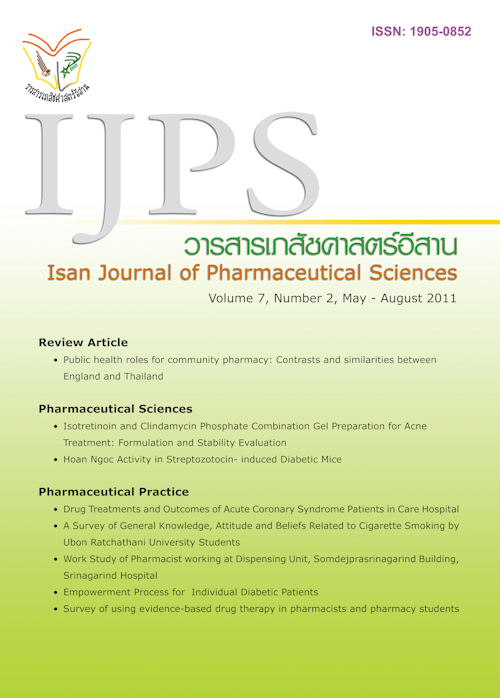Isotretinoin and Clindamycin Phosphate Combination Gel Preparation for Acne Treatment: Formulation and Stability Evaluation
Main Article Content
Abstract
Introduction: Combined formulations of antibiotics and retinoic acid have demonstrated advantageous results for topical acne treatment. The objective of this research was to develop a combination gel formulation of 1% w/w clindamycin phosphate and 0.05% w/w isotretinoin for acne treatment. Materials and methods: In the preformulation study, eighteen formulations were prepared for the selection of appropriate additives i.e. gel-ling agent, preservative, antioxidant, and chelating agent where a short-termed stability testing was performed. A long-term stability testing for the three most stable formulations was then done including physical, chemical, and biological stability, in vitro release of drug using a Franz’s diffusion cell and zone of inhibition to Propionibacterium acne compared to other marketed products. Results: In the preformulation study it was found that carbopol 940, hydroxypropyl methylcellulose and methylcellulose were the most appropriate gelling agents as a clear gel was obtained and the drug concentration remained unchanged after 1-month of accelerated testing at 45oC and hot and cold temperature cycling conditions. After a long-term stability study at 4+1oC, 45+1oC, room temperature and under light exposure for 3 months, the three developed preparations were found physically and chemically stable. Drug remaining in the developed formulations was between 98-102%. Clindamycin releases of the developed prepara-tions ranged 73-75% whereas those of isotretinoin were approximately 95% after 12 h. These release results were comparable to the commercial products (Ref I® and Ref C®). The release kinetics of the developed and commercial products ftted zero-order and Higuchi equations. The investigation of MIC of clindamycin phosphate (1% w/w) and isotetrinoin (0.05% w/w) against Propionibacterium acne (P. acne) using broth dilution technique revealed the MIC concentration of 31.25 and 625 µg/ml, respectively, and these results showed the combination drug was better than the individual drugs alone. The zone of inhibition to P. acne of the developed formulations was equal to Ref C® and better than Ref I®. Conclusion: The developed formulations demonstrated comparable results on drug release rate and stability under accelerated test condition compared to commercial products whereas inhibition activity gave better results.
Article Details
In the case that some parts are used by others The author must Confirm that obtaining permission to use some of the original authors. And must attach evidence That the permission has been included
References
Cambazard F. Clinical efficacy of Velac®, a new tretinoin and clindamycin phosphate gel in acne vulgaris. J Eur Acad Dermato Venereo 1998; 11 (Suppl): S20-S27.
Gollnick H, Schramm M. Topical therapy in acne. J Eur Acad Dermato Venereo 1998; 11(supp 1): 8-12.
Hermes B, Praetel C, Henz BM. Medium dose isotretinoin for the treatment of acne. J Eur Acad Dermato Venereo 1998, 11(2): 117-121.
Khairuzzaman A, Ahmed SU, Savva M, Patel NK. Zero-order release of aspirin, theophylline and atenolol in water from novel methylcellulose glutarate matrix tablets. Int J Pharm. 2006, 318(1-2): 15-21.
Khunkitti W, Aromdee C, Taweechaisupapong S, Lertsa-titthanakorn P. In vitro bioactivities of essential oils used for acne control. Int J Aromather 2006, 16: 43-49.
Layton AM, Cunliff WJ. Guidelines for optimal use of isotretinoin in acne. J Am Acad Dermato 1992, 27(6): S2-S7.
Rakwathin J. Approach for light stability testing of drugs. Bangkok, Niyomvittaya 1997.
Wang F, Saidel GM, Gao J. A mechanistic model of controlled drug release from polymer millirods: Effects of excipients and complex binding, J Control Release 2007, 119(1): 111-120.
Webster GF. Topical tretinoin in acne therapy. J Am Acad Dermatol 1998, 39: S38-44.
West DP and Lee E. Acne Vulgaris. Pharmacotherapy 6th Ed. London: The Pharmaceutical Press. 2005: 1757.White GM. Acne Therapy. Adv Dermatol 1999; 14:29-58.

